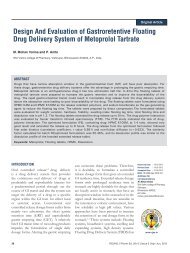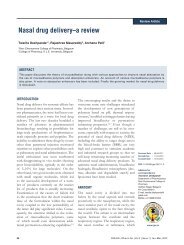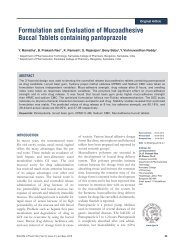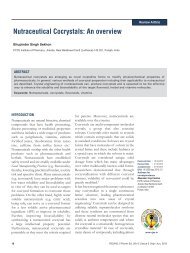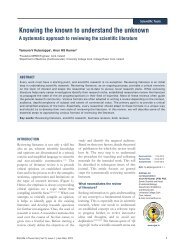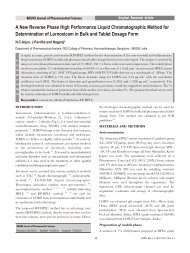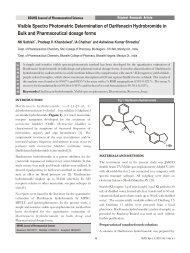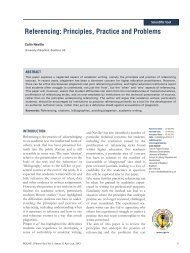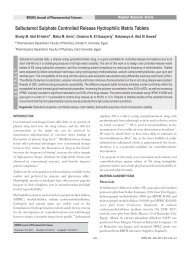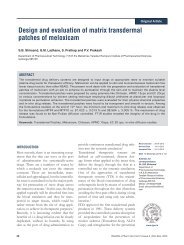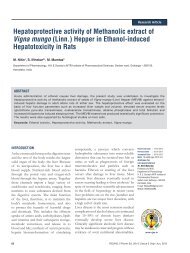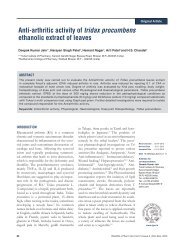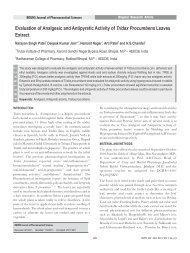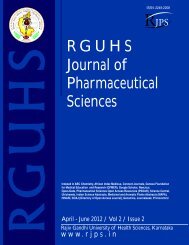Chitosan Loaded Mucoadhesive Microspheres of Gliclazide - Journal
Chitosan Loaded Mucoadhesive Microspheres of Gliclazide - Journal
Chitosan Loaded Mucoadhesive Microspheres of Gliclazide - Journal
You also want an ePaper? Increase the reach of your titles
YUMPU automatically turns print PDFs into web optimized ePapers that Google loves.
A B S T R A C T<br />
RGUHS <strong>Journal</strong> <strong>of</strong> Pharmaceutical Sciences<br />
Influence <strong>of</strong> Vitamin C with Lansoprazole in Pylorus Ligation Induced Ulcer<br />
Model in Rats<br />
Nitin M*, Prasad K, Girish M, Ather Javed, Chetan M and Krunal S<br />
Department <strong>of</strong> Pharmacology, HKES College <strong>of</strong> Pharmacy, Sedam Road, Gulbarga-585105, Karnataka, India.<br />
Gastric hyperacidity and ulceration <strong>of</strong> stomach mucosa due to various factors are serious health problems <strong>of</strong> global concern. Though<br />
currently available drugs provide adequate relief against ulcer, the problem <strong>of</strong> relapse has eluded success. Hence an attempt is being<br />
made to find a therapy with more efficacy and better results. The present study was designed to evaluate the combination effect <strong>of</strong><br />
vitamin C with lansoprazole against pylorus ligation induced ulcer model in rats. The antiulcer effect <strong>of</strong> the combination <strong>of</strong> vitamin C 4.5<br />
mg/200 g and lansoprazole 0.54 mg/200 g b.w orally was compared with the reference standard lansoprazole 0.54 mg/200 g b.w orally.<br />
The ulcer index was calculated and other biochemical parameters <strong>of</strong> gastric juice were estimated. The ulcer index <strong>of</strong> combination<br />
showed significant (P < 0.05) reduction while other biochemical parameters like volume, pH, free acidity and total acidity <strong>of</strong> gastric juice<br />
showed highly significant (P < 0.001) reduction when compared to control and standard lansoprazole. The percentage protection <strong>of</strong><br />
combination was 94.3% as compared to standard lansoprazole 82.8%. Thus the combination group was found to be synergistic in nature<br />
when compared to lansoprazole alone.<br />
Keywords: Antiulcer activity, vitamin C, lansoprazole, pylorus ligation, ulcer index.<br />
INTRODUCTION<br />
Gastric ulcer, the most common disorder <strong>of</strong> GIT has<br />
1<br />
multifunctional causes in its pathophysiology . The<br />
pathophysiology <strong>of</strong> peptic ulcer has been centralized on an<br />
imbalance between aggressive and protective factors in the<br />
stomach such as acid-pepsin secretion, mucosal barrier,<br />
mucus secretion, blood flow, cellular regeneration,<br />
prostaglandins and epidermal growth factors. Various causes<br />
<strong>of</strong> gastric ulceration include stress, alcohol, Helicobacter pylori<br />
and use <strong>of</strong> NSAIDs have been shown to be mediated largely<br />
through generation <strong>of</strong> reactive oxygen species (ROS),<br />
2<br />
especially the hydroxyl radical . A number <strong>of</strong> excellent drugs,<br />
developed over the decades have proven useful in controlling<br />
hyperacidity and ulceration but their long term use is reported<br />
to have various side effects. Hence the investigation with an<br />
objective to find a therapy with more efficacy and lesser side<br />
effects.<br />
Vitamin-C is a well known antioxidant that neutralizes<br />
various reactive oxygen species such as superoxide radical,<br />
3<br />
singlet oxygen, hydrogen peroxide , alkoxyl, hydroxyl radical<br />
3<br />
directly by hydrogen donation and also neutralizes the radical<br />
4<br />
form <strong>of</strong> other antioxidants like glutathione & vitamin-E .<br />
Apart from scavenging free radicals it translates haemeoxgenase-1<br />
mRNA into active protein, which then may exert<br />
gastroprotection by its antioxidant and vasodilative<br />
RGUHS <strong>Journal</strong> <strong>of</strong> Pharmaceutical Sciences<br />
Received: 12/3/2011, Modified: 28/7/2011, Accepted: 20/8/2011<br />
127<br />
Original Research Article<br />
5<br />
properties . Hence an attempt was made to study the<br />
combination effect <strong>of</strong> vitamin C with antisecretory drugs like<br />
lansoprazole. Lansoprazole is a proton pump inhibitor that<br />
+ +<br />
suppresses the gastric acid secretion by inhibiting H K<br />
ATPase pump. The FDA has approved it for treatment and<br />
prevention <strong>of</strong> recurrence <strong>of</strong> NSAIDs associated gastric ulcers<br />
6<br />
in patients who continue NSAID use . It is more potent, has<br />
longer duration <strong>of</strong> action, better bioavailability and lesser<br />
drug interaction than other drugs. Therefore, the present<br />
study is designed to evaluate the combination <strong>of</strong> vitamin C<br />
and lansoprazole against pylorus ligation induced ulcer<br />
model.<br />
MATERIALS AND METHODS<br />
Albino wistar rats <strong>of</strong> either sex weighing between 180 to 220 g<br />
were selected for the present study. The animals were<br />
acclimatized for seven days and housed under standard<br />
conditions <strong>of</strong> temperature (25±2°C) and relative humidity<br />
(30-70%) with a 12:12 light-dark cycle. The animals were fed<br />
with standard pellet diet (Hindustan liver co. Mumbai) and<br />
water ad libitum. Pure drug samples <strong>of</strong> lansoprazole and<br />
vitamin C were procured from Lee Pharmaceuticals<br />
(Hyderabad.) and Wockhardt Ltd (Aurangabad,<br />
Maharashtra.). The dose calculations were extension <strong>of</strong><br />
7<br />
human dose based on body surface area . Animal studies were<br />
performed with prior permission <strong>of</strong> Institutional Animal<br />
Ethics Committee (IAEC) <strong>of</strong> H.K.E.S College <strong>of</strong> pharmacy,<br />
Gulbarga (Protocol No. HKECOP/ IAEC/ 16/ 2009-10/<br />
CPCSEA).<br />
RJPS, Jul - Sep, 2011/ Vol 1/ Issue 2



